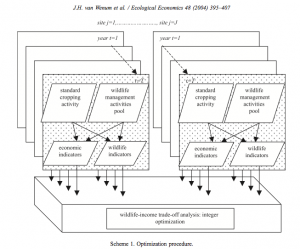LOCATION-SPECIFIC MODELING FOROPTIMIZING WILDLIFEMANAGEMENT ON CROP FARMS
By: J.H. van Wenum, G.A.A Wossink, and J.A. Renkema
This article analyses the hypothesized economic benefits from incorporating wildlife on crop-farms will receive if they do rewild their property. The experiment is based on farmlands in the Netherlands. The experiment was constructed by comparing farmland data of fixed-location crops versus a model that involved rotating wildlife conservation. The reasoning behind this proposal was because they noticed that with increasing development in rural regions there was a consequential loss of wildlife habitat effecting overall wildlife richness. This experiment was also looking to support the countries farm regulations 1760/87 and 2078/92, that supports the idea that coexistence between crop farms and wildlife will be overall more financially beneficial for farmers. These regulations suggest farmers to take look at primarily conserving areas on the farm that will cost the least. The scientists also looked to reduce two major agricultural practices that they noted have been the most detrimental to wildlife in the Netherlands. The first is the use of chemicals on the crops and the second is the emission of those chemicals used on the land.
Some of the proposed methods of rewilding were to focus on the field margins, incorporate winter cover crops, as well as using ditch banks. These are all methods that are believed to require the least amount of chemical input as well as the least costly. The land was split up into sections that focused on the regular cropping activities, right beside wildlife management activities and observed overtime for the effects the wildlife incorporation methods had on the business financially by using various equations that included all the financial inputs, which in turn would produce the overall number of species in direct response to the amount farmers were investing.
The experiment used a combination of rotating crops in the field margins that were more likely to grow, cost less, and would be able to provide habitat for wildlife, while protecting the inner more valuable crops. Some of the vegetation used were grasses, potatoes, and natural vegetation. As a result of the experiment they saw that the incorporation of planting the field margins, provided more financially versus leaving the field margins uncropped and using chemicals to keep away wildlife. The cost of chemicals as well as the cost of replacing plants that have a harder time growing in locations with less fertile soils. The rewilding project gives purpose to these infertile soils as well as reducing the amount of chemicals required to keep away pests. I found it interesting that these plants were in a way used a biological pesticide, providing the wildlife with a distraction changing their focus from the vegetation that the farmers most rely on for an income, but in an environmentally friendly manner.
Overall this model, though created and focused in the Netherlands, could be one that is presented to the farmers here who may be reluctant and skeptical of the rewilding movement. This article shows the potential that rewilding can bring financially, though it isn’t an instant outcome, with due time the act of conservation began to pay for itself. I feel as though if this model could be brought forth and used on varying agricultural locations it could overtime be perfected into a base model that would allow all farmers to follow or at least consider applying. It faces head on the struggles that financially could hold back the farmers, as their priorities are to provide food not only for themselves, but their surrounding neighbors as well. In today’s times I feel as though the art of farming has been so industrialized that all that is occurring is expansion with no consideration for the lives affected, human and non-human. I think that rewilding will again bridge this gap between life and agriculture, that slowly fades as technology and production rates increase.
-John Truong
